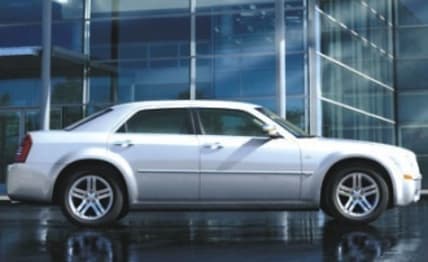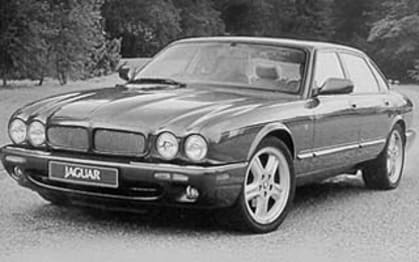
Used Chrysler 300C review: 2005-2006
- Chrysler 300C
- Chrysler 300C 2006
- Chrysler 300C 2005
- Chrysler 300C Reviews
- Chrysler Reviews
- Chrysler Sedan Range
- Sedan
- Chrysler
- Used Car Reviews
- Buying tips
There was a time when American cars reigned supreme over the Australian motoring landscape. It was a time when bigger was believed better and the biggest was best, when automotive prestige was measured by the metre.
It’s not so long ago the local market was split into two camps, the British and the American, from which the locally built Holden and Falcon both sprung.
British cars were typically small, cramped and underpowered, and regarded by many as unreliable, whereas American cars were large and comfortable with slow-revving, understressed engines that were able to cover long distances with ease, and they were reliable.
Many Australians in the 1940s and ’50s aspired to own an American car of the sort that was being built and sold by Holden and Ford. But by the time Chrysler released the 300C in 2005, there had been a seismic shift in the local market and American cars were largely regarded as massive gas guzzlers that were poorly built and less refined than those built by the Europeans and Japanese that had come to dominate the market.
But the 300C had a number of things going for it that would help it find its niche in the market. American cars still had a following here, even if it was relatively small, it was built and backed by DaimlerChrysler, and it was very distinctively styled.
MODEL WATCH
There has been a lot of discussion about styling in recent times. It centred on the criticism that all cars looked similar, if not the same.
It was a fair cop, although designers would argue that the demands for fuel-efficiency and effective packaging locked them into a certain style that meant all cars would resemble each other to some degree.
Then along came Chrysler with a different set of styling rules, one that said a car could look different and still meet the demands for aerodynamics and packaging.
The 300C was a surprising hit. With its big, bold chrome grille, tall slab sides and chopped roofline it could only have come from America, but it caught the imagination of a section of the local motoring public.
Time spent in a 300C and it quickly became evident that it was a head turner. People might not necessarily have known what it was, but they sure took notice of it and wanted to find out.
The 300C was a big car in the true American style, but it wasn’t typical of the big cars that once defined, and almost destroyed, the American car industry.
This one had Mercedes-Benz stamped all over its mechanical package, if not its styling. Benz owned Chrysler at the time and there was plenty of cross-pollination going on, even if there were few parts that could be interchanged between the brands.
Mercedes’ influence was largely behind the scenes in the way things were done rather than a direct parts swap. As a result the 300C boasted more sophistication than most other American cars could.
Chrysler was aiming to steal a slice of the big car market from the likes of the Fairlane/LTD and Statesman/Caprice with the 300C, and it succeeded mostly to the detriment of the big Fords.
Under the bonnet was either a 183 kW 3.5-litre single overhead camshaft V6 or a 250 kW 5.7-litre Hemi V8 that boasted cylinder deactivation to save on fuel bills.
When appropriate the V8 engine’s electronics would switch off a number of cylinders and the engine would cruise on four cylinders. Plant the foot and all eight cylinders would answer the call with a howl that gladdened the heart of any old-time petrolhead.
The aim of the cylinder deactivation – it was called MDS – was to save fuel and Chrysler claimed it was good for 10 to 20 per cent.
The V6 model was given a four-speed auto, but the V8 got a five-speed auto with a slapstick manual change,
On the road the 300C was surprisingly un-American in its dynamics. Instead of the expected sloppiness it steered with precision and feel, braked confidently, and the handling was well balanced and reassuring.
Not such a surprise was the 300C’s ride, which was comfortable and absorbent with good isolation and little noise intrusion, even on its 18-inch wheels and tyres.
Inside, the 300C was reserved, well laid-out, nicely finished and easy to use. It was also relatively roomy and very well equipped.
Standard equipment included climate controlled air, cruise, fog lamps, CD stacker, remote central locking, full electrics and full leather trim.
IN THE SHOP
It’s early days in the lifespan of the 300C, but owners report few problems so far. Nothing major has come to light; the issues owners have reported are fairly minor and have been quickly addressed by Chrysler.
The build quality is of a much higher standard than expected, no doubt the result of Mercedes-Benz setting a high benchmark for its then-American offshoot.
From all reports the 300C appears robust and reliable so simply drive the car and note any noises, vibrations or odours that don’t seem as through they should be there.
The softish ride can result in damage to the underbody and suspension if driven too fast over speed humps so make note of any knocks or noise coming from the suspension.
Given that a number of 300Cs have been modified, and lowered in particular, check for damage as a result of bottoming-out on the road, kerbs and driveways.
Replacing very low profile tyres of the type fitted to large diameter alloy wheels like the aftermarket wheels often fitted by owners can be expensive so check the price of the tyres before deciding on a car with big wheels.
IN A CRUNCH
Mass is a great protector when it comes to a crash and the 300C is well endowed in that area coming in at more than 1800 kg.
Being a large car the 300C is not as agile as a smaller one, but its chassis is well balanced with ESP helping out, its brakes, which are ABS-assisted, are powerful, and its steering lets the driver know what’s going on, so it has a powerful primary safety package.
Bags all round complete a modern safety arsenal that will provide good occupant protection come crash time.
AT THE PUMP
A heavy car with a big V8 isn’t a recipe for low fuel consumption so be prepared for a shock at the pump.
The cylinder deactivation system on the Hemi V8 is a mitigating factor in the V8’s favour, but the 5.7-litre V8 will still be thirsty.
Expect 15 L/100 km around town and 12 on the highway for both V6 and V8 models.
OWNER’S VIEW
Shane Hann first noticed the 300C when on holiday in Canada in 2005. He had no idea what it was, but absolutely loved the look of it with its blunt, aggressive front and chop-top side view. When he returned home he researched the car on the net and determined that he would buy one if Chrysler ever imported it. When they did he was one of the first to place an order. Back then these cars were still relatively unknown, and the amount of looks and comments were astounding, the 300C turned more heads than just about any car on the road. Talk about stroke the ego, he says. He still loves driving it; he loves the attention it gets and the envious looks from P-platers! He has done a few mods to the car, namely changing the exhaust so the Hemi can really sing, fitting 22-inch rims, and dropping the ride height by about 35 mm. The power is plentiful and the car accelerates much quicker than most people expect. It has a very comfortable ride and is actually quite a luxurious and comfortable car inside.
Richard Satora loves his 2006 V8 300C. It has real road presence, he says, unlike any car on the street at the moment and sometimes people are mesmerized as you drive by, and it’s not unusual for complete strangers to give you the thumbs up. The cylinder shutout system is now on everyone’s menu and it does make the fuel consumption pretty good for a big car like this. Like Shane, Richard has modified his 300C with a body kit and exhaust system, as well as lowering it and fitting it with 22-inch wheels. Richard says he was always a Holden man, but the Chrysler has won him over for a few more years.
Paul Carton is still grinning after two years and 30,000 km at the wheel of a 300C. He says it’s big and comfortable, but oozes power, and he loves driving it. He gets under 15 L/100 km commuting and around 11 on the highway run, and he says he’s happy with that. On the downside he discovered the softness of the front end when he drove over a speed hump for the first time, and there have been a couple of minor issues with the boot lid badge and a sticking door handle, both of which were promptly fixed.
LOOK FOR
• Plenty of admiring glances
• Head turning styling
• Hemi V8 performance
• reasonable fuel economy for a heavy V8 car
• Comfortable ride
• Reassuring handling
THE BOTTOM LINE
Striking looks turn heads like no other, but the beauty of the 300C is more than skin deep.
RATING
79/100
Pricing guides
Range and Specs
| Vehicle | Specs | Price* | |
|---|---|---|---|
| 5.7 Hemi V8 | 5.7L, PULP, 5 SP AUTO | $11,110 – 15,180 | 2005 Chrysler 300C 2005 5.7 Hemi V8 Pricing and Specs |
| 3.5 V6 | 3.5L, PULP, 5 SP AUTO | $10,010 – 13,640 | 2005 Chrysler 300C 2005 3.5 V6 Pricing and Specs |
Other cars to consider
$10,010
Lowest price, based on third party pricing data





































